翻译比赛
翻译比赛规则和评分标准

翻译比赛规则和评分标准
规则
1. 参赛者必须按时提交所要翻译的文本,不能延期。
2. 翻译比赛采用线上提交形式,请参赛者在指定的时间内将翻译文本通过指定渠道提交。
3. 参赛者需要确保翻译文本的准确性和流畅性,尽量做到与原文一致,同时保持语言的质量。
4. 所选用的语言应与原文相符,且翻译稿要清晰地传达原文的意思。
5. 参赛者提交翻译文本时应保持文本格式良好,包括正确的标点符号和段落结构。
评分标准
准确性(40%)
准确性是翻译的基本要求。
评分时将根据参赛者翻译文本与原文的一致程度进行评分,原文与翻译文本意思上的对应关系应尽可能保持一致。
流畅性(30%)
流畅性是指翻译文本的连贯性和可读性。
参赛者需要通过运用恰当的词汇、语法和句式,使翻译文本在语言表达上更为流畅。
质量(20%)
质量评分主要针对翻译的语言质量,包括选词、语法、标点等方面。
参赛者应注意使用准确的词汇,正确的语法结构,以及适当的标点符号。
格式(10%)
格式评分主要评价参赛者提交的翻译文本的格式规范程度。
参赛者应注意文本的排版,标点的使用以及段落结构等。
以上是我们对翻译比赛的规则和评分标准的说明,请参赛者按照规则要求准备并提交翻译文本。
祝好运!。
英语单词翻译比赛方案

英语单词翻译比赛方案英语单词翻译比赛方案一、比赛目的英语单词翻译比赛旨在提高参赛选手的英语词汇水平和翻译能力,培养其对英语文化的理解与热爱,激发英语学习的兴趣。
二、比赛形式本次英语单词翻译比赛采取个人参赛的形式,每位参赛选手需通过笔试环节进行初赛和复赛的选拔,最后决出获奖名单。
三、比赛内容1. 初赛:初赛共分为两个环节,笔试和口试。
(1) 笔试环节:参赛选手需在规定时间内完成一套单词翻译题目,包括中英互译、词汇填空、句子翻译等。
(2) 口试环节:根据笔试成绩,选取优秀的选手进行口试环节,要求选手能够准确、流利地口译短文段落。
2. 复赛:复赛环节设置即兴翻译和短文翻译两个环节。
(1) 即兴翻译:从一篇给定的英语短文中,选取难度适当的句子,要求参赛选手即兴翻译成中文,并解释其含义。
(2) 短文翻译:参赛选手需在规定时间内将一篇给定的中文短文准确、流利地翻译成英文。
四、比赛时间和地点1. 时间:本次比赛共分为两个阶段,初赛和复赛,初赛时间为XX月XX日,复赛时间为XX月XX日。
2. 地点:初赛和复赛均在参赛选手所在的学校或指定的考场进行。
五、参赛资格及报名方式1. 参赛资格:本次比赛面向全校中学生开放,不限年级和专业。
2. 报名方式:学校通过官方网站或线下通知方式发布报名信息,参赛选手需填写相关报名表格并缴纳报名费用。
六、评分标准1. 笔试环节:根据答卷正确答题数量和正确率进行评分,每道题目的分数权重相等。
2. 口试环节:根据选手的口译准确性、流利程度、语音语调等进行评分,每个环节的分数权重相等。
3. 复赛即兴翻译环节:根据选手的翻译准确性、难度和解释的准确性进行评分,分数权重为即兴翻译70%、解释准确性30%。
4. 复赛短文翻译环节:根据选手的翻译准确性、流利程度、语法和语义的准确性进行评分,分数权重为准确性50%、流利程度30%、语法和语义20%。
七、奖项设置1. 初赛:根据笔试和口试的综合成绩进行排名,设立一、二、三等奖,并颁发相应证书和奖品。
翻译比赛评分表
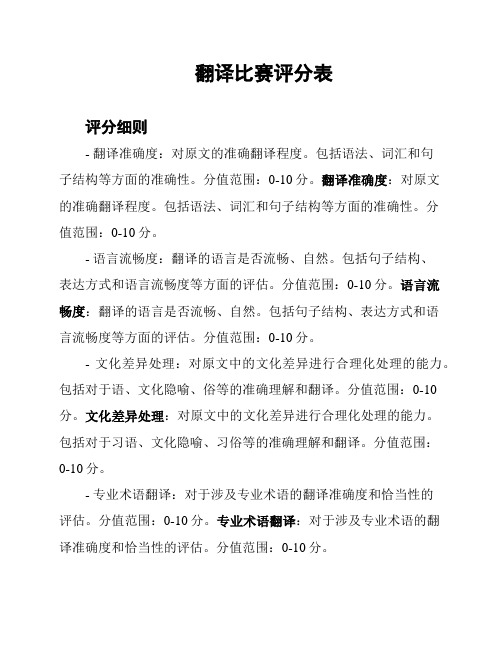
翻译比赛评分表评分细则- 翻译准确度:对原文的准确翻译程度。
包括语法、词汇和句子结构等方面的准确性。
分值范围:0-10分。
翻译准确度:对原文的准确翻译程度。
包括语法、词汇和句子结构等方面的准确性。
分值范围:0-10分。
- 语言流畅度:翻译的语言是否流畅、自然。
包括句子结构、表达方式和语言流畅度等方面的评估。
分值范围:0-10分。
语言流畅度:翻译的语言是否流畅、自然。
包括句子结构、表达方式和语言流畅度等方面的评估。
分值范围:0-10分。
- 文化差异处理:对原文中的文化差异进行合理化处理的能力。
包括对于语、文化隐喻、俗等的准确理解和翻译。
分值范围:0-10分。
文化差异处理:对原文中的文化差异进行合理化处理的能力。
包括对于习语、文化隐喻、习俗等的准确理解和翻译。
分值范围:0-10分。
- 专业术语翻译:对于涉及专业术语的翻译准确度和恰当性的评估。
分值范围:0-10分。
专业术语翻译:对于涉及专业术语的翻译准确度和恰当性的评估。
分值范围:0-10分。
- 文档结构和格式:对于翻译文档的结构和格式的评估。
包括标题、段落、标点符号等方面的评估。
分值范围:0-10分。
文档结构和格式:对于翻译文档的结构和格式的评估。
包括标题、段落、标点符号等方面的评估。
分值范围:0-10分。
评分标准总分评估- 总分范围:0-50分。
- 分数评估:0-10分为不及格;10-20分为及格;20-30分为中等;30-40分为良好;40-50分为优秀。
请根据以上评分标准对翻译比赛进行评估和打分。
评委需全面客观地进行评分,并对每个细则进行细致评估。
评分结果将作为评选比赛优胜者的重要依据。
感谢您的投入和支持!> 注意:以上评分标准仅供参考,如有需要可根据实际情况进行调整。
学生翻译比赛方案
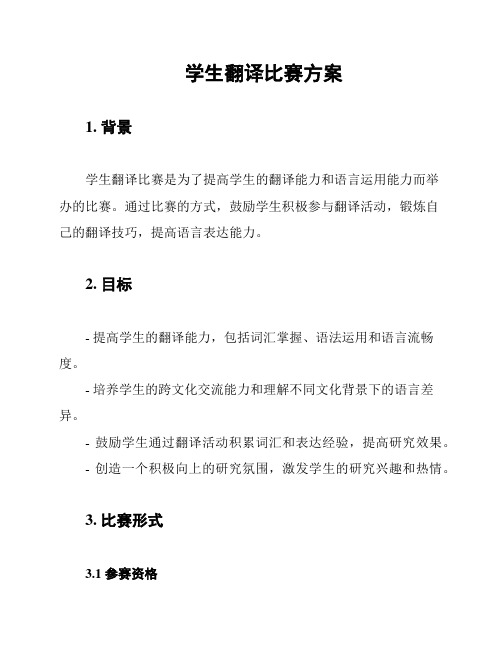
学生翻译比赛方案1. 背景学生翻译比赛是为了提高学生的翻译能力和语言运用能力而举办的比赛。
通过比赛的方式,鼓励学生积极参与翻译活动,锻炼自己的翻译技巧,提高语言表达能力。
2. 目标- 提高学生的翻译能力,包括词汇掌握、语法运用和语言流畅度。
- 培养学生的跨文化交流能力和理解不同文化背景下的语言差异。
- 鼓励学生通过翻译活动积累词汇和表达经验,提高研究效果。
- 创造一个积极向上的研究氛围,激发学生的研究兴趣和热情。
3. 比赛形式3.1 参赛资格- 所有在校学生均可报名参加。
- 参赛学生需具备一定的外语水平,包括英语、法语、西班牙语等。
- 参赛学生可以组队参赛,每队不超过3人。
3.2 比赛内容- 比赛内容涵盖多个领域,如商务、科技、文化等。
- 比赛题目将根据参赛学生的外语水平进行分级设置,确保公平竞赛。
- 比赛内容可以是口译或笔译,以适应不同学生的翻译能力。
3.3 比赛方式- 比赛采用线上线下相结合的方式进行。
- 每个参赛队伍将接收到一份翻译任务,在规定时间内完成翻译工作。
- 线上比赛将通过在线翻译平台进行,确保公平公正。
- 线下决赛将邀请专业翻译人员担任评委,对选手的翻译质量和表现进行评判。
3.4 奖项设置- 比赛设立一等奖、二等奖和三等奖,并颁发相应证书。
- 鼓励参赛学生积极参与,参与奖将颁发给所有完成比赛的学生。
- 奖项设置将根据参赛学生的实际表现和翻译质量进行评定。
4. 组织与安排4.1 比赛筹备- 设立组织委员会,负责比赛的筹备与组织。
- 确定比赛的时间、地点和参赛资格等细节。
- 开展宣传工作,鼓励学生踊跃报名参加比赛。
4.2 比赛流程- 报名:学生通过线上报名系统进行报名,包括个人信息和外语水平等相关信息。
- 初赛:参赛学生按照设定时间进行线上翻译任务,并提交作品。
- 复赛:初赛中优秀的学生将晋级到复赛阶段,继续进行线上翻译任务。
- 决赛:复赛中表现出色的学生将进入决赛,进行线下现场翻译表演。
tournament翻译
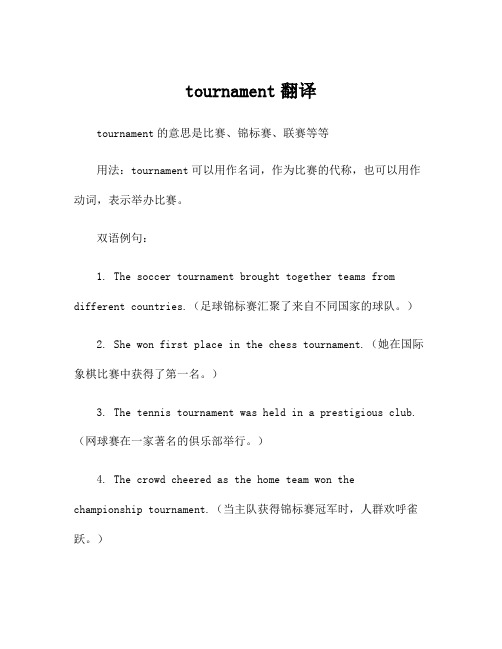
tournament翻译tournament的意思是比赛、锦标赛、联赛等等用法:tournament可以用作名词,作为比赛的代称,也可以用作动词,表示举办比赛。
双语例句:1. The soccer tournament brought together teams from different countries.(足球锦标赛汇聚了来自不同国家的球队。
)2. She won first place in the chess tournament.(她在国际象棋比赛中获得了第一名。
)3. The tennis tournament was held in a prestigious club. (网球赛在一家著名的俱乐部举行。
)4. The crowd cheered as the home team won the championship tournament.(当主队获得锦标赛冠军时,人群欢呼雀跃。
)5. The organizing committee decided to cancel the basketball tournament due to the Covid-19 pandemic.(组委会决定因新冠流行病而取消篮球比赛。
)6. The golf tournament is scheduled to start next week.(高尔夫锦标赛定于下周开始。
)7. The local newspaper reported on the tennis tournament, highlighting the players' strengths and weaknesses. (当地报纸报道了网球比赛,强调了选手的优点和缺点。
)8. The charity tournament raised over ten thousanddollars for local causes. (慈善比赛为当地慈善事业筹集了一万多美元的资金。
翻译大赛总结:从参与到获奖的心路历程

翻译大赛总结:从参与到获奖的心路历程2023年的翻译大赛已圆满结束,让我来分享一下我的心路历程,从参与到获奖。
首先,我认为参加翻译大赛不仅是一种锻炼个人翻译能力的机会,更是一个展示自己的平台。
今年的翻译大赛分为笔译和口译两个部分,我选择了参加笔译部分。
在比赛之前,我花费了很多时间和精力准备,包括阅读相关专业书籍、翻译文章练习以及参加线下培训。
这一切的努力都是为了在比赛中取得好的成绩。
比赛的过程是紧张而刺激的,我在比赛中面对的是新的语言难题,需要在有限的时间里完成对一篇外文文章的翻译。
除了语言水平,效率和准确度也是必不可少的,在比赛中我感受到了时间的紧迫和压力的巨大,但我努力克服了内心的紧张和不安,全身心地投入到了翻译中。
经过一段时间的紧张等待,我的翻译稿提交成功,等待评审结果。
此时我的心情是复杂的,有期待,有惊喜,更有担忧。
我深知自己的水平还有许多需要改进和提高的地方,但同时也深信自己在比赛中的付出和努力。
最终的结果揭晓了,我很幸运能够获得比赛的银奖。
这是我翻译生涯中的一次重要的荣誉,更是我努力奋斗的成果。
通过这次比赛,我意识到翻译是一个需要不断提高和探索的领域,而翻译大赛则是一个展示自己的好机会。
总之,我很感谢这次翻译大赛给予了我一个展示自己并不断提高的机会。
虽然比赛的过程很紧张和刺激,但我从中学到了很多,无论
是对自己的能力有了更深的认识,还是对翻译领域有了更深入的思考。
我相信通过继续努力和学习,我会在翻译大赛中取得更大的突破和成就。
翻译大赛主持稿范文
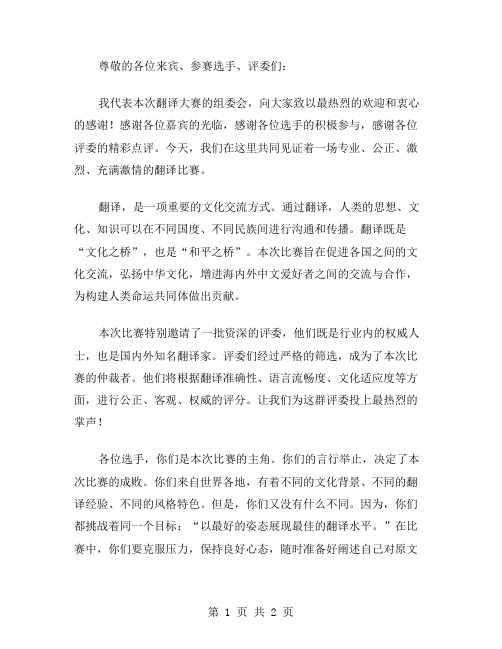
尊敬的各位来宾、参赛选手、评委们:我代表本次翻译大赛的组委会,向大家致以最热烈的欢迎和衷心的感谢!感谢各位嘉宾的光临,感谢各位选手的积极参与,感谢各位评委的精彩点评。
今天,我们在这里共同见证着一场专业、公正、激烈、充满激情的翻译比赛。
翻译,是一项重要的文化交流方式。
通过翻译,人类的思想、文化、知识可以在不同国度、不同民族间进行沟通和传播。
翻译既是“文化之桥”,也是“和平之桥”。
本次比赛旨在促进各国之间的文化交流,弘扬中华文化,增进海内外中文爱好者之间的交流与合作,为构建人类命运共同体做出贡献。
本次比赛特别邀请了一批资深的评委,他们既是行业内的权威人士,也是国内外知名翻译家。
评委们经过严格的筛选,成为了本次比赛的仲裁者。
他们将根据翻译准确性、语言流畅度、文化适应度等方面,进行公正、客观、权威的评分。
让我们为这群评委投上最热烈的掌声!各位选手,你们是本次比赛的主角。
你们的言行举止,决定了本次比赛的成败。
你们来自世界各地,有着不同的文化背景、不同的翻译经验、不同的风格特色。
但是,你们又没有什么不同。
因为,你们都挑战着同一个目标:“以最好的姿态展现最佳的翻译水平。
”在比赛中,你们要克服压力,保持良好心态,随时准备好阐述自己对原文细致的理解,体现出自己的翻译技巧和思维深度。
期望各位选手能够在比赛中实現自己的潜能,最终成为最优秀的那位。
我想借此机会,感谢所有支持本次比赛的单位和个人,感谢所有志愿者的辛勤付出。
本次翻译大赛的成功举办,全体组织者、参赛选手、观众和嘉宾的共同努力、智慧结晶,我们也期许着这样的文化活动能够一直持续下去,我们在这里共同为文化交流、为语言交流、为文明交流而努力!愿本次比赛圆满成功!谢谢大家!。
翻译比赛规则和评分标准

翻译比赛规则和评分标准
1. 比赛规则
- 参赛者应在规定的时间内完成翻译任务,超过时间将被扣分或取消参赛资格。
- 翻译的内容应准确无误、通顺流畅,尽可能忠实于原文的意思。
- 参赛者可以使用电子词典或在线翻译工具辅助翻译,但不能抄袭他人翻译的内容。
- 禁止使用任何违法、攻击性或侮辱性语言。
- 参赛者必须以个人名义参赛,不得代表他人参赛。
2. 评分标准
翻译比赛将按照以下评分标准进行评判:
2.1 准确性(40分)
- 翻译的内容与原文之间的准确度和一致性。
- 翻译是否捕捉到原文的核心意思。
- 是否有任何误译或遗漏关键信息。
2.2 流畅度(30分)
- 翻译的语句是否通顺流畅,符合目标语言的语法和惯用法。
- 是否有过多的词语重复或冗长的表达方式。
2.3 创意和风格(20分)
- 是否能够灵活运用翻译技巧和语言风格,使译文更加生动和自然。
- 是否能够在翻译过程中展示个人独特的创意和见解。
2.4 格式和规范(10分)
- 翻译稿件是否符合规定的格式要求,例如字数限制、字体和行间距等。
- 是否遵循官方语言规范,如拼写、标点和用词准确性。
以上评分标准将由一组专业的评委根据各项要素进行综合评定,得分最高者将获得比赛的胜利。
祝愿参赛者在比赛中取得好成绩!。
翻译比赛的技巧
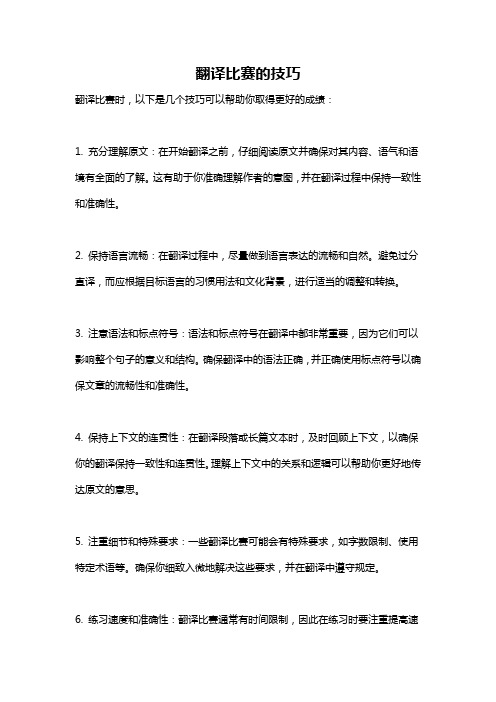
翻译比赛的技巧
翻译比赛时,以下是几个技巧可以帮助你取得更好的成绩:
1. 充分理解原文:在开始翻译之前,仔细阅读原文并确保对其内容、语气和语境有全面的了解。
这有助于你准确理解作者的意图,并在翻译过程中保持一致性和准确性。
2. 保持语言流畅:在翻译过程中,尽量做到语言表达的流畅和自然。
避免过分直译,而应根据目标语言的习惯用法和文化背景,进行适当的调整和转换。
3. 注意语法和标点符号:语法和标点符号在翻译中都非常重要,因为它们可以影响整个句子的意义和结构。
确保翻译中的语法正确,并正确使用标点符号以确保文章的流畅性和准确性。
4. 保持上下文的连贯性:在翻译段落或长篇文本时,及时回顾上下文,以确保你的翻译保持一致性和连贯性。
理解上下文中的关系和逻辑可以帮助你更好地传达原文的意思。
5. 注重细节和特殊要求:一些翻译比赛可能会有特殊要求,如字数限制、使用特定术语等。
确保你细致入微地解决这些要求,并在翻译中遵守规定。
6. 练习速度和准确性:翻译比赛通常有时间限制,因此在练习时要注重提高速
度和准确性。
通过反复练习和模拟赛事,提高自己的翻译效率和质量,以应对比赛的压力。
7. 查阅参考资料:在翻译过程中,如果遇到生词、专有名词或其他难以理解的内容,不要犹豫查阅相关的参考资料。
确保你对文本内容的理解准确无误。
8. 保持审校意识:一旦完成翻译,花费一些时间仔细审查和校对你的翻译。
检查拼写、语法和句子结构等错误,并对语言表达进行进一步的调整和改进。
最重要的是多加练习,提升翻译技巧和速度,同时保持对语言的敏感性和适应能力。
英语翻译比赛方案
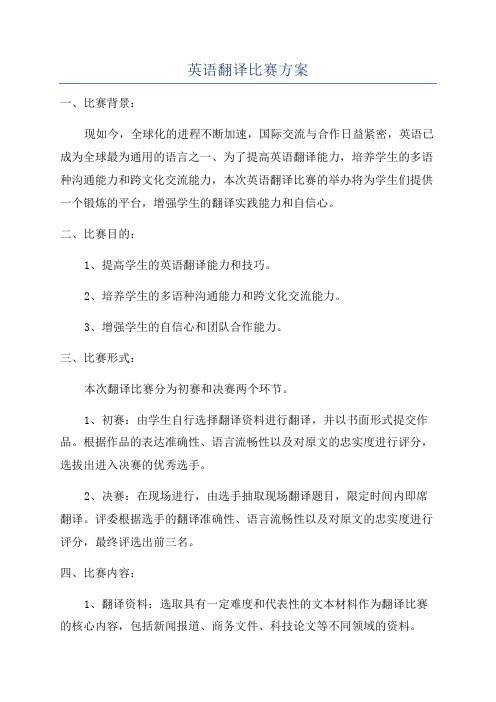
英语翻译比赛方案一、比赛背景:现如今,全球化的进程不断加速,国际交流与合作日益紧密,英语已成为全球最为通用的语言之一、为了提高英语翻译能力,培养学生的多语种沟通能力和跨文化交流能力,本次英语翻译比赛的举办将为学生们提供一个锻炼的平台,增强学生的翻译实践能力和自信心。
二、比赛目的:1、提高学生的英语翻译能力和技巧。
2、培养学生的多语种沟通能力和跨文化交流能力。
3、增强学生的自信心和团队合作能力。
三、比赛形式:本次翻译比赛分为初赛和决赛两个环节。
1、初赛:由学生自行选择翻译资料进行翻译,并以书面形式提交作品。
根据作品的表达准确性、语言流畅性以及对原文的忠实度进行评分,选拔出进入决赛的优秀选手。
2、决赛:在现场进行,由选手抽取现场翻译题目,限定时间内即席翻译。
评委根据选手的翻译准确性、语言流畅性以及对原文的忠实度进行评分,最终评选出前三名。
四、比赛内容:1、翻译资料:选取具有一定难度和代表性的文本材料作为翻译比赛的核心内容,包括新闻报道、商务文件、科技论文等不同领域的资料。
2、翻译要求:在规定的时间内,选手需将翻译资料准确地翻译成中文或英文,并保持语言表达的流畅性和原文的风格特点。
同时,选手还需要忠实地传达原文的信息和意图。
五、比赛评分:1、初赛评分:以作品的表达准确性、语言流畅性以及对原文的忠实度作为评分标准,由组委会成员进行评分。
2、决赛评分:以翻译的准确性、语言流畅性以及对原文的忠实度作为评分标准,由评委团成员进行评分。
六、比赛奖励:1、冠军奖:奖金5000元人民币和荣誉证书。
2、亚军奖:奖金3000元人民币和荣誉证书。
3、季军奖:奖金2000元人民币和荣誉证书。
4、其他入围决赛的选手将获得荣誉证书。
七、比赛安排:初赛:1、确定比赛的时间、地点和参赛要求。
2、发布比赛公告,并接受选手报名。
3、选手自行选择翻译资料进行翻译,提交作品。
决赛:1、确定决赛时间、地点和参赛选手。
2、抽取现场翻译题目。
3、比赛进行评分,并最终评选出前三名获奖选手。
英语翻译比赛方案
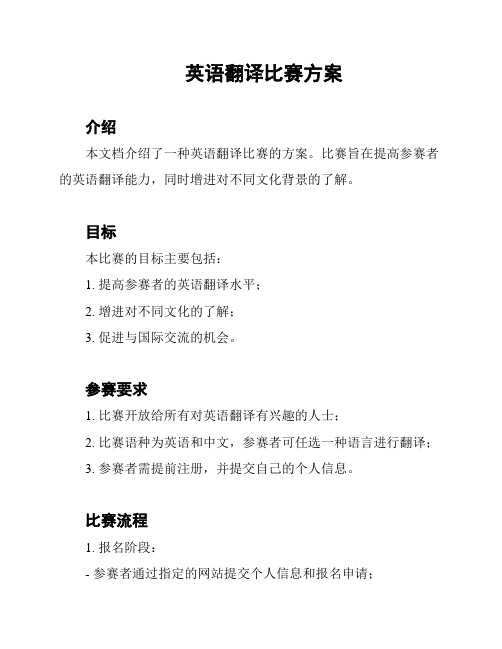
英语翻译比赛方案
介绍
本文档介绍了一种英语翻译比赛的方案。
比赛旨在提高参赛者的英语翻译能力,同时增进对不同文化背景的了解。
目标
本比赛的目标主要包括:
1. 提高参赛者的英语翻译水平;
2. 增进对不同文化的了解;
3. 促进与国际交流的机会。
参赛要求
1. 比赛开放给所有对英语翻译有兴趣的人士;
2. 比赛语种为英语和中文,参赛者可任选一种语言进行翻译;
3. 参赛者需提前注册,并提交自己的个人信息。
比赛流程
1. 报名阶段:
- 参赛者通过指定的网站提交个人信息和报名申请;
- 主办方对报名信息进行审核并发送确认邮件。
2. 初赛:
- 选择3-5个语言题材各异的英语段落,主办方提供给参赛者;
- 参赛者按照规定时间将翻译作品提交给主办方;
- 主办方评选出前50名进入决赛。
3. 决赛:
- 决赛阶段将进行现场翻译比赛;
- 参赛者将现场翻译一个给定的英文段落,并进行演讲;
- 决策委员会根据翻译准确性、语言流畅度和表达能力评选出
前3名获奖者。
奖项设置
1. 第一名:奖金1000美元和荣誉证书;
2. 第二名:奖金500美元和荣誉证书;
3. 第三名:奖金200美元和荣誉证书。
后续发展
1. 主办方将举办定期的英语翻译培训活动,为参赛者提供提高翻译水平的机会;
2. 根据比赛表现,优秀选手将有机会参加国际翻译交流活动。
以上为英语翻译比赛方案的简要介绍。
希望通过这样的比赛能够促进英语翻译水平的提高,并加深与不同文化的交流与了解。
全国catti杯翻译大赛
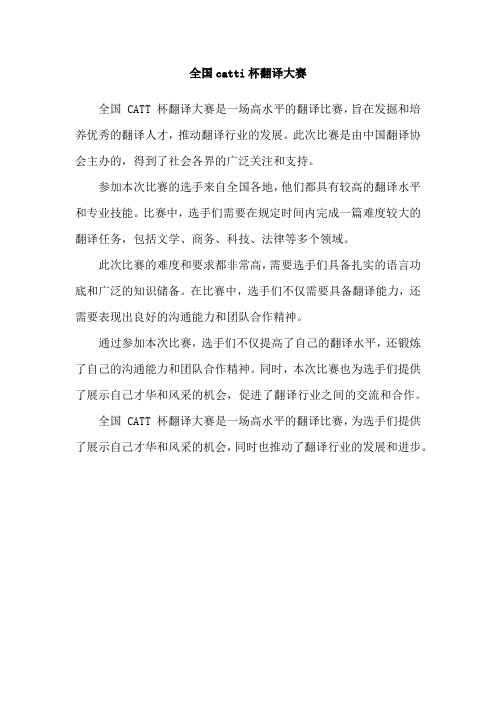
全国catti杯翻译大赛
全国 CATT 杯翻译大赛是一场高水平的翻译比赛,旨在发掘和培养优秀的翻译人才,推动翻译行业的发展。
此次比赛是由中国翻译协会主办的,得到了社会各界的广泛关注和支持。
参加本次比赛的选手来自全国各地,他们都具有较高的翻译水平和专业技能。
比赛中,选手们需要在规定时间内完成一篇难度较大的翻译任务,包括文学、商务、科技、法律等多个领域。
此次比赛的难度和要求都非常高,需要选手们具备扎实的语言功底和广泛的知识储备。
在比赛中,选手们不仅需要具备翻译能力,还需要表现出良好的沟通能力和团队合作精神。
通过参加本次比赛,选手们不仅提高了自己的翻译水平,还锻炼了自己的沟通能力和团队合作精神。
同时,本次比赛也为选手们提供了展示自己才华和风采的机会,促进了翻译行业之间的交流和合作。
全国 CATT 杯翻译大赛是一场高水平的翻译比赛,为选手们提供了展示自己才华和风采的机会,同时也推动了翻译行业的发展和进步。
翻译大赛活动策划方案
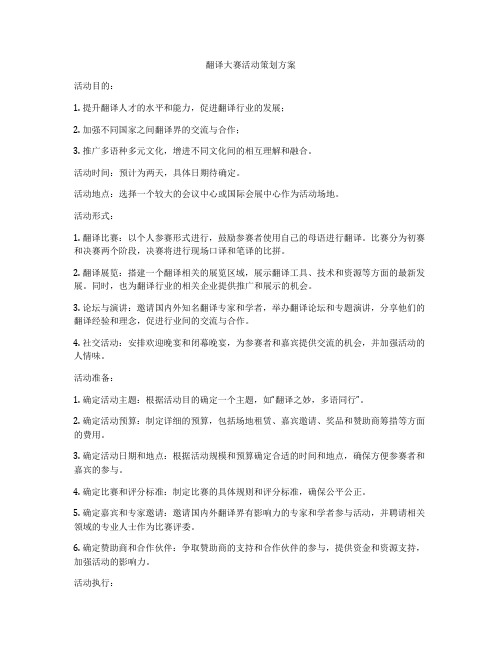
翻译大赛活动策划方案活动目的:1. 提升翻译人才的水平和能力,促进翻译行业的发展;2. 加强不同国家之间翻译界的交流与合作;3. 推广多语种多元文化,增进不同文化间的相互理解和融合。
活动时间:预计为两天,具体日期待确定。
活动地点:选择一个较大的会议中心或国际会展中心作为活动场地。
活动形式:1. 翻译比赛:以个人参赛形式进行,鼓励参赛者使用自己的母语进行翻译。
比赛分为初赛和决赛两个阶段,决赛将进行现场口译和笔译的比拼。
2. 翻译展览:搭建一个翻译相关的展览区域,展示翻译工具、技术和资源等方面的最新发展。
同时,也为翻译行业的相关企业提供推广和展示的机会。
3. 论坛与演讲:邀请国内外知名翻译专家和学者,举办翻译论坛和专题演讲,分享他们的翻译经验和理念,促进行业间的交流与合作。
4. 社交活动:安排欢迎晚宴和闭幕晚宴,为参赛者和嘉宾提供交流的机会,并加强活动的人情味。
活动准备:1. 确定活动主题:根据活动目的确定一个主题,如“翻译之妙,多语同行”。
2. 确定活动预算:制定详细的预算,包括场地租赁、嘉宾邀请、奖品和赞助商筹措等方面的费用。
3. 确定活动日期和地点:根据活动规模和预算确定合适的时间和地点,确保方便参赛者和嘉宾的参与。
4. 确定比赛和评分标准:制定比赛的具体规则和评分标准,确保公平公正。
5. 确定嘉宾和专家邀请:邀请国内外翻译界有影响力的专家和学者参与活动,并聘请相关领域的专业人士作为比赛评委。
6. 确定赞助商和合作伙伴:争取赞助商的支持和合作伙伴的参与,提供资金和资源支持,加强活动的影响力。
活动执行:1. 活动宣传:制作宣传册、海报和新闻稿,通过社交媒体、电视、报纸和网站等渠道进行广泛宣传。
邀请翻译界的知名人士和新闻媒体进行报道。
2. 参赛者招募:通过各大翻译学院、翻译协会和社交媒体等渠道招募参赛者,并提供报名指南和参赛须知。
3. 比赛准备:安排比赛的赛题和参赛材料,并准备比赛所需的设备和场地。
英语翻译比赛评分标准

英语翻译比赛评分标准本文档旨在为英语翻译比赛提供评分标准。
以下是评分标准的几个重要方面:1. 文章结构与组织 (25分)- 逻辑清晰: 文章要有明确的引言、主体和结论。
评分会考虑文章的逻辑性和结构的组织性。
逻辑清晰: 文章要有明确的引言、主体和结论。
评分会考虑文章的逻辑性和结构的组织性。
- 过渡流畅: 句子间要有合理的过渡词语和连贯性,以便读者能够轻松跟随翻译的思路。
过渡流畅: 句子间要有合理的过渡词语和连贯性,以便读者能够轻松跟随翻译的思路。
- 段落分明: 文章要分为合理的段落,每段都应该有一个清晰明确的主题。
段落分明: 文章要分为合理的段落,每段都应该有一个清晰明确的主题。
2. 语言与语法 (30分)- 准确性: 翻译应尽可能准确地表达原文的意思,精确理解并用适当的词汇和语法表达。
准确性: 翻译应尽可能准确地表达原文的意思,精确理解并用适当的词汇和语法表达。
- 流利度: 翻译应具备流利度,使用恰当的语言和表达方式,以便读者易于理解。
流利度: 翻译应具备流利度,使用恰当的语言和表达方式,以便读者易于理解。
- 语法与拼写: 翻译应遵守英语的语法和拼写规则,减少语法和拼写错误的出现。
语法与拼写: 翻译应遵守英语的语法和拼写规则,减少语法和拼写错误的出现。
3. 词汇与表达 (20分)- 词汇丰富: 翻译应使用丰富多样的词汇,展示广泛的词汇量并准确运用于相应的语境中。
词汇丰富: 翻译应使用丰富多样的词汇,展示广泛的词汇量并准确运用于相应的语境中。
- 表达准确: 翻译应准确表达原文的含义并保持适当的表达风格。
表达准确: 翻译应准确表达原文的含义并保持适当的表达风格。
- 翻译技巧: 翻译应灵活运用翻译技巧,如注释、括号、转述等,以帮助读者更好地理解翻译内容。
翻译技巧: 翻译应灵活运用翻译技巧,如注释、括号、转述等,以帮助读者更好地理解翻译内容。
4. 文化适应性 (15分)- 文化意识: 翻译应体现出对不同文化差异的敏感性,准确传达原文中的文化信息。
have a match翻译中文
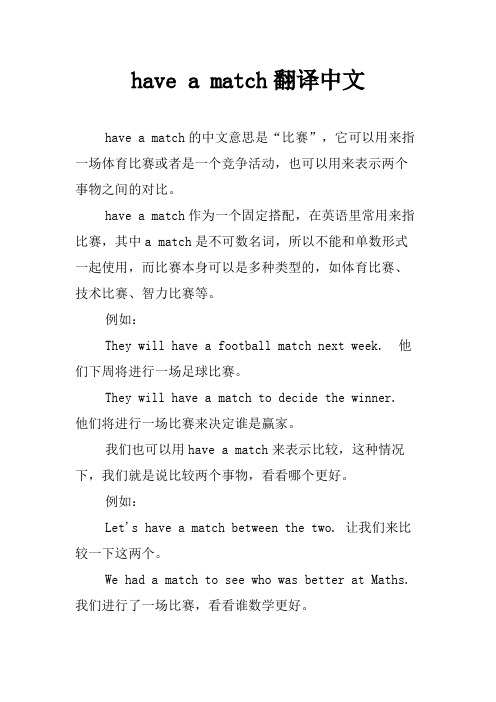
have a match翻译中文
have a match的中文意思是“比赛”,它可以用来指一场体育比赛或者是一个竞争活动,也可以用来表示两个事物之间的对比。
have a match作为一个固定搭配,在英语里常用来指比赛,其中a match是不可数名词,所以不能和单数形式一起使用,而比赛本身可以是多种类型的,如体育比赛、技术比赛、智力比赛等。
例如:
They will have a football match next week. 他们下周将进行一场足球比赛。
They will have a match to decide the winner. 他们将进行一场比赛来决定谁是赢家。
我们也可以用have a match来表示比较,这种情况下,我们就是说比较两个事物,看看哪个更好。
例如:
Let's have a match between the two. 让我们来比较一下这两个。
We had a match to see who was better at Maths. 我们进行了一场比赛,看看谁数学更好。
用have a match作为一个固定搭配表达比赛或者比较的时候,它的单数形式必须用match,而不能用matches,因为它是不可数名词,表示一次比赛。
have a match是一个常用的固定搭配,在英语里它有两种意思,一种是指一场比赛,另一种是指一个比较。
它是一个不可数名词,必须用它的单数形式,即match。
中外传播杯英语翻译大赛

中外传播杯英语翻译大赛
这个比赛通常会涉及到各种不同类型的翻译,包括但不限于文学作品、新闻报道、商务文件、科技文献等。
参赛者需要具备良好的英语水平和出色的翻译能力,同时还需要具备对不同语言和文化的敏感度和理解力。
比赛的题目和内容通常会涉及到一定的专业领域,因此参赛者需要具备一定的专业知识和背景。
参与这样的比赛对于参赛者来说有着诸多好处。
首先,通过参与比赛,他们可以提高自己的翻译能力和语言表达能力,锻炼自己的语言思维和逻辑能力。
其次,比赛还为他们提供了一个展示自己才华的舞台,有机会得到专业人士的指导和认可。
最重要的是,这样的比赛可以促进中外语言之间的交流与理解,有助于加深不同文化背景下人们的沟通与合作。
总的来说,中外传播杯英语翻译大赛是一个有益的活动,它不仅促进了英语翻译领域的发展,也为参与者提供了一个展示自己才华的舞台,同时也有助于促进中外语言之间的交流与理解。
希望这样的比赛能够继续举办下去,为更多有志于语言交流与翻译的人士提供机会和平台。
全国高校创新英语翻译赛含金量
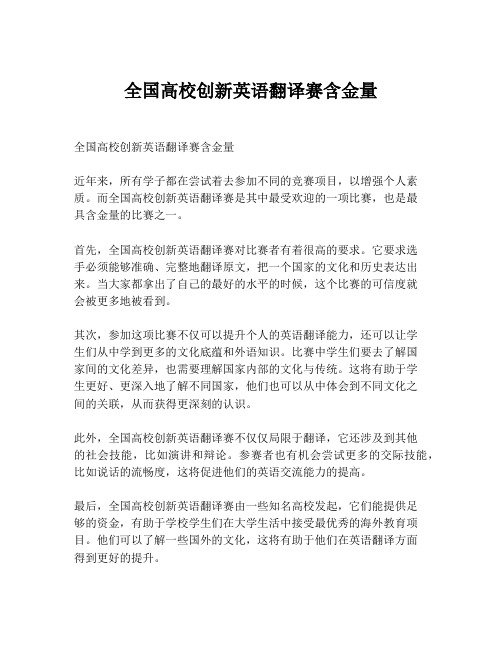
全国高校创新英语翻译赛含金量
全国高校创新英语翻译赛含金量
近年来,所有学子都在尝试着去参加不同的竞赛项目,以增强个人素质。
而全国高校创新英语翻译赛是其中最受欢迎的一项比赛,也是最
具含金量的比赛之一。
首先,全国高校创新英语翻译赛对比赛者有着很高的要求。
它要求选
手必须能够准确、完整地翻译原文,把一个国家的文化和历史表达出来。
当大家都拿出了自己的最好的水平的时候,这个比赛的可信度就
会被更多地被看到。
其次,参加这项比赛不仅可以提升个人的英语翻译能力,还可以让学
生们从中学到更多的文化底蕴和外语知识。
比赛中学生们要去了解国
家间的文化差异,也需要理解国家内部的文化与传统。
这将有助于学
生更好、更深入地了解不同国家,他们也可以从中体会到不同文化之
间的关联,从而获得更深刻的认识。
此外,全国高校创新英语翻译赛不仅仅局限于翻译,它还涉及到其他
的社会技能,比如演讲和辩论。
参赛者也有机会尝试更多的交际技能,比如说话的流畅度,这将促进他们的英语交流能力的提高。
最后,全国高校创新英语翻译赛由一些知名高校发起,它们能提供足
够的资金,有助于学校学生们在大学生活中接受最优秀的海外教育项目。
他们可以了解一些国外的文化,这将有助于他们在英语翻译方面
得到更好的提升。
总之,全国高校创新英语翻译赛含金量非常高,它能有效提升学生的英语翻译技能,培养学生社会技能,也能为学生提供最优秀的海外学习机会。
外研社翻译大赛口译

外研社翻译大赛口译摘要:1.外研社翻译大赛简介2.初赛内容与形式3.复赛内容与形式4.比赛技巧与建议5.决赛注意事项正文:外研社翻译大赛是我国翻译领域的一项重要赛事,旨在选拔和培养优秀的翻译人才。
该比赛分为初赛、复赛和决赛三个阶段,本文将为您详细解析初赛和复赛的内容与形式,并提供一些比赛技巧和建议。
一、初赛内容与形式初赛主要测试参赛者的听力理解能力和英语翻译技巧。
根据前年专业组选手的反馈,初赛全是听力选择题,题目较为简单。
然而,每个选项都相差无几,关键在于把握细节。
因此,选手在准备初赛时,应着重提高听力水平,并锻炼捕捉关键信息的能力。
二、复赛内容与形式复赛相较于初赛,更加注重参赛者的翻译实际操作能力。
听译环节中,中译英和英译中的比例各占一半。
题目要求选手直接将听到的内容翻译成英文或中文,并写下来提交。
这一环节的题目涉及多个领域,如文化、科技、教育等。
虽然难度不大,但选手需要具备较强的词汇量和行业知识。
三、比赛技巧与建议1.提高听力水平:多听英语原声资料,如电影、新闻、播客等,锻炼听力理解能力。
2.注重词汇积累:扩大词汇量,了解各类词汇的用法,特别是专业领域词汇。
3.学习翻译技巧:了解翻译的基本原理和方法,提高翻译准确性和流畅度。
4.动笔练习:多做翻译练习题,培养笔译能力。
四、决赛注意事项决赛阶段,选手需要进行口译实战,不仅考验翻译能力,还需具备良好的心理素质。
在决赛前,选手应充分了解口译技巧,如断句、语音、语调等。
此外,注意在比赛中保持冷静,遇到难题时,尽量保持口译的流畅性。
总之,外研社翻译大赛不仅为选手提供了一个展示自己翻译才能的平台,也有助于提高我国翻译人才的整体水平。
我校同学catti杯笔译
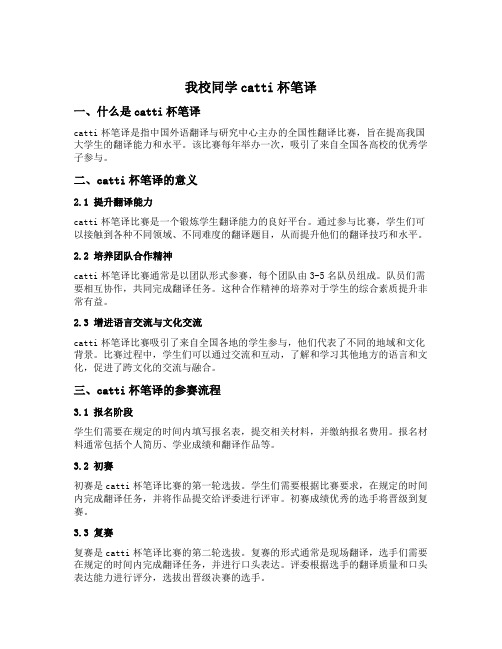
我校同学catti杯笔译一、什么是catti杯笔译catti杯笔译是指中国外语翻译与研究中心主办的全国性翻译比赛,旨在提高我国大学生的翻译能力和水平。
该比赛每年举办一次,吸引了来自全国各高校的优秀学子参与。
二、catti杯笔译的意义2.1 提升翻译能力catti杯笔译比赛是一个锻炼学生翻译能力的良好平台。
通过参与比赛,学生们可以接触到各种不同领域、不同难度的翻译题目,从而提升他们的翻译技巧和水平。
2.2 培养团队合作精神catti杯笔译比赛通常是以团队形式参赛,每个团队由3-5名队员组成。
队员们需要相互协作,共同完成翻译任务。
这种合作精神的培养对于学生的综合素质提升非常有益。
2.3 增进语言交流与文化交流catti杯笔译比赛吸引了来自全国各地的学生参与,他们代表了不同的地域和文化背景。
比赛过程中,学生们可以通过交流和互动,了解和学习其他地方的语言和文化,促进了跨文化的交流与融合。
三、catti杯笔译的参赛流程3.1 报名阶段学生们需要在规定的时间内填写报名表,提交相关材料,并缴纳报名费用。
报名材料通常包括个人简历、学业成绩和翻译作品等。
3.2 初赛初赛是catti杯笔译比赛的第一轮选拔。
学生们需要根据比赛要求,在规定的时间内完成翻译任务,并将作品提交给评委进行评审。
初赛成绩优秀的选手将晋级到复赛。
3.3 复赛复赛是catti杯笔译比赛的第二轮选拔。
复赛的形式通常是现场翻译,选手们需要在规定的时间内完成翻译任务,并进行口头表达。
评委根据选手的翻译质量和口头表达能力进行评分,选拔出晋级决赛的选手。
3.4 决赛决赛是catti杯笔译比赛的最后一轮,也是最激烈的一轮。
决赛通常设有多个赛题,选手们需要根据赛题要求进行翻译,并进行现场口头表达。
评委根据选手的翻译质量、口头表达能力和综合素质进行评分,最终决出比赛的优胜者。
四、catti杯笔译的奖励与收获4.1 奖项设置catti杯笔译比赛设有多个奖项,包括一等奖、二等奖、三等奖以及优秀奖等。
- 1、下载文档前请自行甄别文档内容的完整性,平台不提供额外的编辑、内容补充、找答案等附加服务。
- 2、"仅部分预览"的文档,不可在线预览部分如存在完整性等问题,可反馈申请退款(可完整预览的文档不适用该条件!)。
- 3、如文档侵犯您的权益,请联系客服反馈,我们会尽快为您处理(人工客服工作时间:9:00-18:30)。
2012年第二十四届韩素音青年翻译奖规则及原文2012-01-18 20:49:53| 分类:科研信息|字号订阅中国译协《中国翻译》编辑部与江苏人文环境艺术设计研究院(中国译协江苏培训中心)联合举办第二十四届韩素音青年翻译奖竞赛。
具体参赛规则如下:一、本届竞赛分别设立英译汉和汉译英两个奖项,参赛者可任选一项或同时参加两项竞赛。
二、《中国翻译》2012年第1期以及中国翻译协会网站()韩素音青年翻译奖专栏刊登竞赛规则、竞赛原文;参赛报名表请到中国翻译协会网站韩素音青年翻译奖专栏下载。
三、参赛者年龄:45岁以下(1967年1月1日后出生)。
四、参赛译文须独立完成,杜绝抄袭现象,一经发现,将取消参赛资格。
请参赛者在大赛截稿之日前妥善保存参赛译文,请勿在书报刊、网络等任何媒体公布自己的参赛译文,否则将被取消参赛资格并承担由此造成的一切后果。
五、参赛译文和参赛报名表格式要求:参赛译文应为WORD电子文档,中文宋体、英文Times New Roman字体,全文小四号字,1.5倍行距,文档命名格式为“XXX(姓名)英译汉”或“XXX(姓名)汉译英”。
参赛报名表文档命名格式为“XXX(姓名)英译汉参赛报名表”或“XXX(姓名)汉译英参赛报名表”。
译文正文内请勿书写译者姓名、地址等任何个人信息,否则将被视为无效译文。
每项参赛译文一稿有效,恕不接收修改稿。
六、参赛方式及截稿日期:请参赛者于2012年5月31日(含)前将参赛译文及参赛报名表以电子文档附件形式发送至hansuyin2012@,发送成功的文档得到自动回复后,请勿重复发送。
如需查询是否发送成功,可在6月10日至7月10日之间拨打电话(010)68997177。
本届竞赛不再接收打印稿。
七、参赛者在提交参赛译文后,交寄报名费50元,如同时参加两项竞赛,请交报名费100元。
汇款地址:北京市阜外百万庄大街24号《中国翻译》编辑部,收款人:《中国翻译》编辑部,邮编:100037。
请在汇款单附言上注明“XXX(姓名)参赛报名费”字样。
未交报名费的参赛译文无效。
八、本届竞赛设一、二、三等奖和优秀奖若干名,一、二、三等奖获得者将被授予奖金、奖杯、证书和纪念品,优秀奖获得者将被授予证书和纪念品。
2012年第6期(11月15日出版)《中国翻译》杂志将公布竞赛结果。
九、本届竞赛颁奖典礼将于2012年秋举行,竞赛获奖者将获邀参加颁奖典礼。
十、联系地址:北京市阜外百万庄大街24号《中国翻译》编辑部邮编:100037电话:(010) 68997177;68990246 传真:(010)68995951电子信箱:hansuyin2012@第二十四届韩素音青年翻译奖竞赛评审委员会2012年1月附:第二十四届韩素音青年翻译奖竞赛原文英译汉竞赛原文:It’s Time to Rethink ‘Temporary’We tend to view architecture as permanent, as aspiring to the status of monuments. And that kind of architecture has its place. But so does architecture of a different sort.For most of the first decade of the 2000s, architecture was about the statement building. Whether it was a controversial memorial or an impossibly luxurious condo tower, architecture’s raison d’être was to make a lasting impression. Architecture has always been synonymous with permanence, but should it be?In the last few years, the opposite may be true.Architectural billings are at an all-time low. Major commissions are few and far between. The architecture that’s been making news is fast and fleeting: pop-up shops, food carts, marketplaces, performance spaces. And while many manifestations of the genre have jumped the shark (i.e., a Toys R Us pop-up shop), there is undeniable opportunity in the temporary: it is an apt response to a civilization in flux. And like many prevailing trends —collaborative consumption (a.k.a., “sharing”), community gardens, barter and trade —“temporary” is so retro that it’s become radical.In November, I had the pleasure of moderating Motopia, a panel at University of Southern California’s School of Architecture, with Robert Kronenburg, an architect, professor at University of Liverpool and portable/temporary/mobile guru. Author of a shelf full of books on the topic, including“Flexible: Architecture that Responds to Change,” “Portable Architecture: Design and Technology” and “Houses in Motion: The Genesis,” Kronenburg is a man obsessed.Mobility has an innate potency, Kronenburg believes. Movable environments are more dynamic than static ones, so why should architecture be so static? The idea that perhaps all buildings should n’t aspire to permanence represents a huge shift for architecture. Without that burden, architects, designers, builders and developers can take advantage of and implement current technologies faster. Architecture could be reusable, recyclable and sustainable. Recast in this way, it could better solve seemingly unsolvable problems. And still succeed in creating a sense of place.In his presentation, Kronenburg offered examples of how portable, temporaryarchitecture has been used in every aspect of human activity, including health care (from Florence Nightingale’s redesigned hospitals to the Airstream trailers used as mobile medical clinics during the Kennedy Administration), housing (from yurts to tents to architect Shigeru Ban’s post-earthquake paper houses), culture and commerce (stage sets and Great Exhibition buildings, centuries-old Bouqinistes along the Seine, mobile food, art and music venues offering everything from the recording of stories to tasty crème brulees.)Kronenburg made a compelling argument that the experimentation inherent in such structures challenges preconceived notions about what buildings can and should be. The strategy of temporality, he explained, “adapts to unpredictable demands, provides more for less, and encourages innovatio n.” And he stressed that it’s time for end-users, designers, architects, manufacturers and constructionfirms to rethink their attitude toward temporary, portable and mobile architecture.This is as true for development and city planning as it is for architecture. City-making may have happened all at once at the desks of master planners like Daniel Burnham or Robert Moses, but that’s really not the way things happen today. No single master plan can anticipate the evolving and varied needs of an increasingly diverse population or achieve the resiliency, responsiveness and flexibility that shorter-term, experimental endeavors can. Which is not to say long-term planning doesn’t have its place. The two work well hand in hand. Mike Lydon, founding principal of The Street Plans Collaborative, argues for injecting spontaneity into urban development, and sees these temporary interventions (what he calls “tactical urbanism”) as short-term actions to effect long-term change.Though there’s been tremendous media attention given to quick and cheap projects like San Francisco’s Pavement to Parks and New York’s “gutter cafes,” Lydon sees something bigger than fodder for the style section. “A lot of these things were not just fun and cool,” he says. “It was not just a bottom-up effort. It’s not D.I.Y. urbanism. It’s a continuum of ideas, techniques and tactics being employed at all different scales.”“We’re seeing a lot of these things emerge for three reasons,” Lydon continues. “One, the economy. People have to be more creative about getting things done. Two, the Internet. Even four or five years ago we couldn’t share tactics and techniques via YouTube or Facebook. Something can happen randomly in Dallas and now we can hear about it right away. This is feeding into this idea of growth, of bi-coastal competition between New Yorkand San Francisco, say, about who does the cooler, better things. And three, demographic shifts. Urban neighborhoods are gentrifying, changing. They’re bringing in people looking to improve neighborhoods themselves. People are smart and engaged and working a 40-hour week. But they have enough spare time to get involved and this seems like a natural step.”Lydon isn’t advocating an end to planning but encourages more short-term doing, experimenting, testing (which can be a far more satisfying alternative to waiting for projects to pass). While this may not directly change existing codes or zoning regulations, that’s O.K. because, as Lydon explains, the practices employed “shine a direct light on old ways of thinking, old policies that are in place.”The Dallas group Build a Better Block — whichquickly leapt from a tiny grass-roots collective to an active partner in city endeavors —has demonstrated that when you expose weaknesses, change happens. If their temporary interventions violate existing codes, Build a Better Block just paints a sign informing passers-by of that fact. They have altered regulations in this fashion. Sometimes — not always — bureaucracy gets out of the way and allows for real change to happen.Testing things out can also help developers chart the right course for their projects. Says Lydon, “A developer can really learn what’s working in the neighborhood from a marketplace perspective —it could really inform or change their plans. Hopefully they can ingratiate themselves with the neighborhood and build community. There is real potential if the developers are really looking to do that.”And they are. Brooklyn’s De Kalb Market, for example, was supposed to be in place for just three years, but became a neighborhood center where there hadn’t been much of one before. “People gravitated towards it,” says Lydon. “People like going there. You run the risk of people lamenting the loss of that. The developer would be smart to integrate things like the community garden — [giving residents an] opportunity to keep growing food on the site. The radio station could get a permanent space. The beer garden could be kept.”San Francisco’s PROXY project is similar. Retail, restaurants and cultural spaces housed within an artful configuration of shipping containers, designed by Envelope Architecture and Design, were given a five-year temporary home on government-owned vacant lots in the city’s Hayes Valley neighborhood while developers opted to sit tight during the recession. Affordable housing is promised for the site;the developers will now be able to create it in a neighborhood that has become increasingly vibrant and pedestrian-friendly.On an even larger scale, the major developer Forest City has been testing these ideas of trial and error in the 5M Project in downtown San Francisco. While waiting out the downturn, the folks behind 5M have been beta-testing tenants and uses at their 5th & Mission location, which was (and still is) home to the San Francisco Chronicle and now also to organizations like TechShop, the co-working space HubSoma, the art gallery Intersection for the Arts, the tech company Square and a smattering of food carts to feed those hungry, hardworking tenants. A few years earlier, Forest City would have been more likely to throw up an office tower with some luxury condos on top and call it a day: according to a company vice president, Alexa Arena, the recession allowed Forest City to spend time“re-imagining places for our emerging economy and what kind of environment helps facilitate that.”In “The Interventionist’s Toolkit,” the critic Mimi Zeiger wrote that the real success for D.I.Y. urbanist interventions won’t be based on any one project but will “happen when we can evaluate the movement based on outreach, economic impact, community empowerment, entrepreneurship, sustainability and design. We’re not quite there yet.”She’s right. And one doesn’t have to search for examples of temporary projects that not only failed but did so catastrophically (see: Hurricane Katrina trailers, for example). A huge reason for tactical urbanism’s appeal relates to politics. As one practitioner put it, “We’re doing these things to combat the slowness of government.”But all of this is more than a response to bureaucracy; at its best it’s a bold expression of unfettered thinking and creativity … and there’s certainly not enough of that going around these days. An embrace of the temporary and tactical may not be perfect, but it could be one of the strongest tools in the arsenal of city-building we’ve got.。
